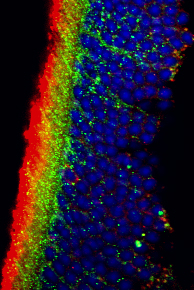Main Second Level Navigation
Derek van der Kooy
PhD, FRSC

Qualification
- Salk Institute, La Jolla, CA, U.S., Research Fellow in Behavioural Neurobiology, 1980-1981.
- Cambridge University, Cambridge, U.K., Research Fellow in Neurochemical Pharmacology, 1980.
- Erasmus University Rotterdam and University of Toronto, PhD in Anatomy, 1980.
- University of British Columbia, MSc in Psychology, 1976.
MY RESEARCH OVERVIEW (GO TO SCIENTIFIC OVERVIEW)
The Development and Function of the Nervous System
In academia, researchers can end up isolated in their departments, detached from what people are doing in other academic communities. The Donnelly Centre facilitates community and communication, and staves off intellectual isolation and opens up a world of new possibilities and discoveries.

Our lab carries out various neuroscience and developmental biology research projects, and has had a history of collaborating. Our lab has collaborative publications with six other Donnelly Centre labs. In particular, we have worked with bioengineering l and genomics labs to understand stem cell lineages and expand specific stem and progenitor cells. The ultimate hope for stem cell research is the use of these endogenous stem cells to replace cells lost to damage or disease.
Our lab has three main areas of interest: learning and memory, developmental and stem cell biology, and the neurobiology of motivation. With respect to learning and memory, we use the power and specificity of modern molecular genetics to reveal the component processes of learning and memory. We are working on whether we can separate associative from non-associative learning, short- from long-term memory, and learning and memory in one sensory modality from that in another sensory modality. In terms of stem cell biology, my lab investigates the nature of stem cells (embryonic and adult), the concept of immortal cells, and the differentiation of embryonic stem cells, which are capable of forming any tissue in the body, to neural stem cells. Indeed, we have discovered the most primitive neural stem cell – th efirst neural cell in the developeing brain. More recently, we discovered adult retinal stem cells in the eye, as well as separate adult pancreatic stem cells. These stem cells may be sued in the future to treat blindness and diabetes. Finally, we are studying the neurobiology of motivation with the overall hypothesis that separate neural mechanisms underlie rewards in naïve versus deprived conditions such as opiates in drug-naïve versus drug-dependent and -deprived organisms.
Visit Dr. Derek van der Kooy's Discover Research profile to learn more.
SCIENTIFIC RESEARCH OVERVIEW
The van der Kooy lab has three main areas of research interest: Neural Development & Stem Cell Biology, the Neurobiology of Motivation, and Learning and Memory Genes.
1. Neural Development & Stem Cell Biology
With respect to Neural Development & Stem Cell Biology we are interested in asymmetric cell division, retinal stem cells, pancreatic stem cells, as well as cell lineage and brain development. Our lab is interested in the lineage steps in the development of the mammalian brain from totipotent embryonic stem (blastocyst) cells to neural stem cells to more restricted neural progenitor cells that make neurons and glia. Of particular interest are the earliest steps in the production of self-renewing neural stem cells from mouse embryonic stem cells, in terms of discovering and testing novel candidate neural determination genes. Neural stem cells also are present in adult and even elderly mammalian brains, and these stem cells are being localized in adult brains and being characterized in terms of their transcriptomes, proliferative kinetics and growth factor requirements in vivo and in vitro. Finally, adult neural stem cells can produce new neurons and glia in adult mammalian brains in vivo and we are testing the ability of these new cells to re-establish function in animal models of human neurological disorders. Our lab discovered adult mouse and human pancreatic stem cells, whose progeny have the ability to produce new endocrine insulin producing cells that may be useful in treating diabetes in the future. Our lab was the first to report retinal stem cells in the adult mouse and human eye. This work has resulted in the ability to grow retinal stem cells in large numbers in the lab and differentiate them into all the different cell types in the retina. More remarkable we found a way to activate retinal stem cells resident in the eye.
2. Neurobiology of Motivation
The primary objective for our Neurobiology of Motivation research is to characterize the neurobiological substrates of motivation. Our overall hypothesis is that separate, double dissociable, neural mechanisms underlie the rewarding effects of opiates in drug naive versus drug-dependent and deprived animals. Lesions of the tegmental pedunculopontine nucleus (TPP) block the conditioned place preferences produced by morphine in drug naive rats, but not in opiate dependent and deprived rats. Dopamine antagonists block the conditioned place preferences produced by morphine in opiate dependent and deprived rats, but not in drug naive rats. We hypothesize that TPP and dopaminergic manipulators identify a double dissociable fracture line in motivational mechanisms that splits a non-deprived motivational process from a deprivation induced motivational process. We suggest that this distinction cuts across motivational stimuli (for example, TPP lesions but not dopamine antagonists block the rewarding properties of food in food sated rats and dopamine antagonists but not TPP lesions block the motivational effects of food deprivation). A similar distinction underlies the rewarding effects of nicotine in drug naïve versus drug dependent individuals.
3. Learning and Memory
A mutational analysis has begun to reveal the component processes of Learning and Memory, our third area of research. We have developed associative (classical conditioning) and non-associative (habituation) learning paradigms using olfactory and taste stimuli in the best-understood multicultural organism, the worm C. elegans. Mutational screens in progress have identified new genes, which code for critical components of associative (lrn-1 and lrn-2) and non-associative (adp-1) learning. These new genes reveal the separable neuronal and molecular substrates underlying associative learning and habituation. Mutations in an insulin gene (ins-1) block selectively memory retrieval but not memory acquisition.
SELECT PUBLICATIONS
- Quiescent Oct4+ Neural Stem Cells (NSCs) Repopulate Ablated Glial Fibrillary Acidic Protein+ NSCs in the Adult Mouse Brain. Stem Cells. Reeve RL, Yammine, SZ, Morshead C and van der Kooy D. Stem Cells, 2017 Sep;35(9):2071-2082.
- β2* nAChRs on VTA dopamine and GABA neurons separately mediate nicotine aversion and reward. Taryn E. Grieder TE, Besson M, Maal-Bared G, Pons S, Maskos U and van der Kooy D. PNAS USA, 2019 Dec 17;116(51):25968-25973.
- Arrestin-mediated Desensitization Enables Olfactory Discrimination in C. elegans. Merritt DM, MacKay-Clackett I, Almeida SMT, Tran C, Ansar S and van der Kooy D. PNAS USA, 2022 July 25; 119 (31) e2116957119.
